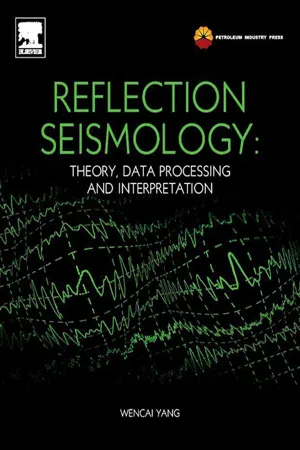
- 272 pages
- English
- ePUB (mobile friendly)
- Available on iOS & Android
About this book
Authored by a geophysicist with more than 50 years of experience in research and instruction, Reflection Seismology: Theory, Data Processing and Interpretation provides a single source of foundational knowledge in reflection seismology principles and theory.Reflection seismology has a broad range of applications and is used primarily by the oil and gas industry to provide high-resolution maps and build a coherent geological story from maps of processed seismic reflections. Combined with seismic attribute analysis and other exploration geophysics tools, it aids geologists and geo-engineers in creating geological models of areas of exploration and extraction interest. Yet as important as reflection seismology is to the hydrocarbon industry, it's difficult to find a single source that synthesizes the topic without having to wade through numerous journal articles from a range of different publishers. This book is a one-stop source of reflection seismology theory, helping scientists navigates through the wealth of new data processing techniques that have emerged in recent years.- Provides geoscientists and geo-engineers with a theoretical framework for navigating the rapid emergence of new data processing techniques- Presents a single source of reflection seismology content instead of a scattering of disparate journal articles- Features more than 100 figures, illustrations, and working examples to aid the reader in retaining key concepts- Arms geophysicists and geo-engineers with a solid foundation in seismic wave equation analysis and interpretation
Frequently asked questions
- Essential is ideal for learners and professionals who enjoy exploring a wide range of subjects. Access the Essential Library with 800,000+ trusted titles and best-sellers across business, personal growth, and the humanities. Includes unlimited reading time and Standard Read Aloud voice.
- Complete: Perfect for advanced learners and researchers needing full, unrestricted access. Unlock 1.4M+ books across hundreds of subjects, including academic and specialized titles. The Complete Plan also includes advanced features like Premium Read Aloud and Research Assistant.
Please note we cannot support devices running on iOS 13 and Android 7 or earlier. Learn more about using the app.
Information
Introduction to the Wave Theory
Abstract
Keywords
1.1 Wave Motion in Continuous Media
Table of contents
- Cover image
- Title page
- Table of Contents
- Copyright
- Preface
- Chapter 1. Introduction to the Wave Theory
- Chapter 2. Elastic Waves in a Perfect Elastic Solid
- Chapter 3. From Elastic Waves to Seismic Waves
- Chapter 4. Wave Equation Reduction with Reflection Seismic Data Processing
- Chapter 5. Integral Solutions of the Wave Equation with Boundary and Initial Value Conditions
- Chapter 6. Decomposition and Continuation of Seismic Wave Field
- Chapter 7. Seismic Inversion
- Appendix. Finite Difference Method for Solving the Acoustic Wave Equation with Velocity and Density Variant Media
- References
- Index